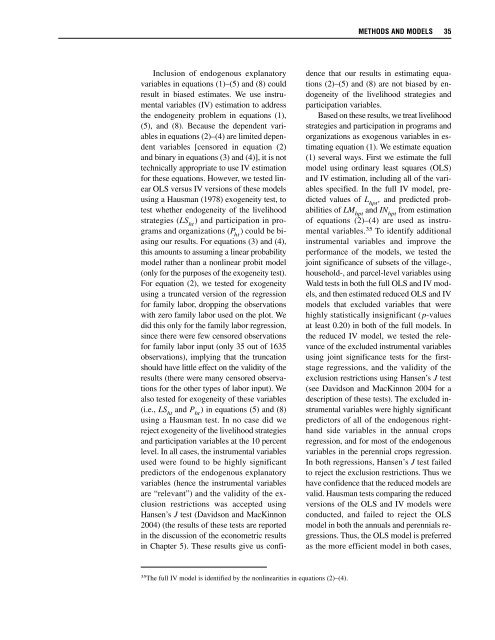Rural Development Policies and Sustainable Land Use in the ...
Rural Development Policies and Sustainable Land Use in the ...
Rural Development Policies and Sustainable Land Use in the ...
Create successful ePaper yourself
Turn your PDF publications into a flip-book with our unique Google optimized e-Paper software.
METHODS AND MODELS 35<br />
Inclusion of endogenous explanatory<br />
variables <strong>in</strong> equations (1)–(5) <strong>and</strong> (8) could<br />
result <strong>in</strong> biased estimates. We use <strong>in</strong>strumental<br />
variables (IV) estimation to address<br />
<strong>the</strong> endogeneity problem <strong>in</strong> equations (1),<br />
(5), <strong>and</strong> (8). Because <strong>the</strong> dependent variables<br />
<strong>in</strong> equations (2)–(4) are limited dependent<br />
variables [censored <strong>in</strong> equation (2)<br />
<strong>and</strong> b<strong>in</strong>ary <strong>in</strong> equations (3) <strong>and</strong> (4)], it is not<br />
technically appropriate to use IV estimation<br />
for <strong>the</strong>se equations. However, we tested l<strong>in</strong>ear<br />
OLS versus IV versions of <strong>the</strong>se models<br />
us<strong>in</strong>g a Hausman (1978) exogeneity test, to<br />
test whe<strong>the</strong>r endogeneity of <strong>the</strong> livelihood<br />
strategies (LS ht<br />
) <strong>and</strong> participation <strong>in</strong> programs<br />
<strong>and</strong> organizations (P ht<br />
) could be bias<strong>in</strong>g<br />
our results. For equations (3) <strong>and</strong> (4),<br />
this amounts to assum<strong>in</strong>g a l<strong>in</strong>ear probability<br />
model ra<strong>the</strong>r than a nonl<strong>in</strong>ear probit model<br />
(only for <strong>the</strong> purposes of <strong>the</strong> exogeneity test).<br />
For equation (2), we tested for exogeneity<br />
us<strong>in</strong>g a truncated version of <strong>the</strong> regression<br />
for family labor, dropp<strong>in</strong>g <strong>the</strong> observations<br />
with zero family labor used on <strong>the</strong> plot. We<br />
did this only for <strong>the</strong> family labor regression,<br />
s<strong>in</strong>ce <strong>the</strong>re were few censored observations<br />
for family labor <strong>in</strong>put (only 35 out of 1635<br />
observations), imply<strong>in</strong>g that <strong>the</strong> truncation<br />
should have little effect on <strong>the</strong> validity of <strong>the</strong><br />
results (<strong>the</strong>re were many censored observations<br />
for <strong>the</strong> o<strong>the</strong>r types of labor <strong>in</strong>put). We<br />
also tested for exogeneity of <strong>the</strong>se variables<br />
(i.e., LS ht<br />
<strong>and</strong> P ht<br />
) <strong>in</strong> equations (5) <strong>and</strong> (8)<br />
us<strong>in</strong>g a Hausman test. In no case did we<br />
reject exogeneity of <strong>the</strong> livelihood strategies<br />
<strong>and</strong> participation variables at <strong>the</strong> 10 percent<br />
level. In all cases, <strong>the</strong> <strong>in</strong>strumental variables<br />
used were found to be highly significant<br />
predictors of <strong>the</strong> endogenous explanatory<br />
variables (hence <strong>the</strong> <strong>in</strong>strumental variables<br />
are “relevant”) <strong>and</strong> <strong>the</strong> validity of <strong>the</strong> exclusion<br />
restrictions was accepted us<strong>in</strong>g<br />
Hansen’s J test (Davidson <strong>and</strong> MacK<strong>in</strong>non<br />
2004) (<strong>the</strong> results of <strong>the</strong>se tests are reported<br />
<strong>in</strong> <strong>the</strong> discussion of <strong>the</strong> econometric results<br />
<strong>in</strong> Chapter 5). These results give us confidence<br />
that our results <strong>in</strong> estimat<strong>in</strong>g equations<br />
(2)–(5) <strong>and</strong> (8) are not biased by endogeneity<br />
of <strong>the</strong> livelihood strategies <strong>and</strong><br />
participation variables.<br />
Based on <strong>the</strong>se results, we treat livelihood<br />
strategies <strong>and</strong> participation <strong>in</strong> programs <strong>and</strong><br />
organizations as exogenous variables <strong>in</strong> estimat<strong>in</strong>g<br />
equation (1). We estimate equation<br />
(1) several ways. First we estimate <strong>the</strong> full<br />
model us<strong>in</strong>g ord<strong>in</strong>ary least squares (OLS)<br />
<strong>and</strong> IV estimation, <strong>in</strong>clud<strong>in</strong>g all of <strong>the</strong> variables<br />
specified. In <strong>the</strong> full IV model, predicted<br />
values of L hpt<br />
, <strong>and</strong> predicted probabilities<br />
of LM hpt<br />
<strong>and</strong> IN hpt<br />
from estimation<br />
of equations (2)–(4) are used as <strong>in</strong>strumental<br />
variables. 35 To identify additional<br />
<strong>in</strong>strumental variables <strong>and</strong> improve <strong>the</strong><br />
performance of <strong>the</strong> models, we tested <strong>the</strong><br />
jo<strong>in</strong>t significance of subsets of <strong>the</strong> village-,<br />
household-, <strong>and</strong> parcel-level variables us<strong>in</strong>g<br />
Wald tests <strong>in</strong> both <strong>the</strong> full OLS <strong>and</strong> IV models,<br />
<strong>and</strong> <strong>the</strong>n estimated reduced OLS <strong>and</strong> IV<br />
models that excluded variables that were<br />
highly statistically <strong>in</strong>significant (p-values<br />
at least 0.20) <strong>in</strong> both of <strong>the</strong> full models. In<br />
<strong>the</strong> reduced IV model, we tested <strong>the</strong> relevance<br />
of <strong>the</strong> excluded <strong>in</strong>strumental variables<br />
us<strong>in</strong>g jo<strong>in</strong>t significance tests for <strong>the</strong> firststage<br />
regressions, <strong>and</strong> <strong>the</strong> validity of <strong>the</strong><br />
exclusion restrictions us<strong>in</strong>g Hansen’s J test<br />
(see Davidson <strong>and</strong> MacK<strong>in</strong>non 2004 for a<br />
description of <strong>the</strong>se tests). The excluded <strong>in</strong>strumental<br />
variables were highly significant<br />
predictors of all of <strong>the</strong> endogenous righth<strong>and</strong><br />
side variables <strong>in</strong> <strong>the</strong> annual crops<br />
regression, <strong>and</strong> for most of <strong>the</strong> endogenous<br />
variables <strong>in</strong> <strong>the</strong> perennial crops regression.<br />
In both regressions, Hansen’s J test failed<br />
to reject <strong>the</strong> exclusion restrictions. Thus we<br />
have confidence that <strong>the</strong> reduced models are<br />
valid. Hausman tests compar<strong>in</strong>g <strong>the</strong> reduced<br />
versions of <strong>the</strong> OLS <strong>and</strong> IV models were<br />
conducted, <strong>and</strong> failed to reject <strong>the</strong> OLS<br />
model <strong>in</strong> both <strong>the</strong> annuals <strong>and</strong> perennials regressions.<br />
Thus, <strong>the</strong> OLS model is preferred<br />
as <strong>the</strong> more efficient model <strong>in</strong> both cases,<br />
35<br />
The full IV model is identified by <strong>the</strong> nonl<strong>in</strong>earities <strong>in</strong> equations (2)–(4).
















